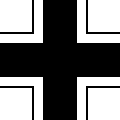Sonderkommando Elbe
| Sonderkommando "ELBE" | |
|---|---|
 | |
| Active | 7 April 1945 |
| Country | |
| Role | Kamikazi inteceptors |
| Size | 180 aircraft 2000 volunteers 300 fighter pilots |
| Engagements | Air war over Germany, 7 April 1945 |
| Aircraft flown | |
| Interceptor | Messerschmitt Bf 109 |
Sonderkommando "ELBE" was the name of a World War II Luftwaffe task force assigned to bring down Allied bombers by ramming German aircraft into the bombers to suspend allied tatical bombing for 4–6 weeks to create a significant amount of the Messerschmitt BF 262 jet fighter. Sonderkommando is literally "special command", and Elbe is a river that runs through Germany to the North Sea. While the Luftwaffe had a ready supply of airplanes at this point in the war, well-trained pilots and fuel were two components in short supply. Despite the grim prospects of survival of such a mission, the unit was not a true "suicide unit" in that the pilots were expected to either attempt to bail out just before colliding with the Allied aircraft, or attempt to bail out after colliding. This is unlike the Japanese kamikaze attacks, in which Japanese pilots loaded their planes up with explosives and therefore had no chance of survival.
The aircraft of choice for this mission was a Bf 109 stripped of armor and armament (The BF-109s usually had 2 synchronized machine guns in the fuselage and later models sported additional cannons in the wings). To accomplish this mission, pilots would typically aim for one of three sensitive areas on the bombers. The easiest part of an Allied bomber to damage was the empennage, or tail assembly, with its delicate control surfaces on the elevator and rudder. Another potential target were the engine nacelles, which connected to the highly explosive fuel system. The final target was also the most gruesome—the cockpit. One of the most famous reports of cockpit ramming was against the B-24 Liberator, the "Palace of Dallas".
Adding to the last ditch nature of this task force, the only mission was flown on 7 April 1945 by a sortie of 120 Bf 109s. While only 15 Allied bombers were attacked in this manner, eight were successfully destroyed.[1][2][3]
History
Similarities with the Japanese kamikazes
Order of battle
Successful missions
Rank / Name / Former Unit e/a Unit Status
- Uffz. Heinrich Rosner, (ex-III/JG.102), 2 B-24 Liberators of the 389th Bomb Group, 1st B-24 rammed was named "Palace of Dallas", 2nd B-24 unknown[4],, Survived
- Obfw. Werner Linder, (ex-EJG.1), 1 B-17 Flying Fortress 388th Bomb Group[5], KIA
- Fhr. Eberhard Prock, 1 B-17 452nd Bomb Group,[6] KIA, Shot while descending in his parachute.
- Fw. Reinhold Hedwig, 1 B-17 452nd Bomb Group,[7] KIA, Shot down by 339 Fighter Group P-51.
- Uffz. Werner Zell, 1 B-17 100th Bomb Group. [8]
- Uffz. Werner Zell, 1 B-17 452nd Bomb Group,[9] WIA Shot down by P-51.
- Ogfr. Horst Siedel, 1 B-17 452nd Bomb Group,[10] KIA
- Lt. Hans Nagel, (ex-IV/JG.102), 1 B-17 490th Bomb Group,[11] KIA, Shot it down by conventional armament, damaged a second B-17 by ramming.
- Fritz Marktschaftel
- Uffz. Klaus Hahn, 1 B-17 487th Bomb Group[12], WIA - Left arm by 4 P-51Ds fire.
- Heinrich Henkel, 1 B-24 Liberator, called "Sacktime" 467th Bomb Group[13], Survived.
- Unknown Bf 109 pilot, 1 B-17 100th Bomb Group,[14] KIA
- Unknown Bf 109 pilot, 1 B-17 490th Bomb Group, [15] KIA
Luftwaffe records claim at least 22 to 24 American aircraft fell victim to the Sonderkommando Elbe unit.
(WIA - wounded in action / KIA - killed in action)
References
- ^ "German Pilot Perspective". RootsWeb. Retrieved 2007-10-02.
- ^ [1]
- ^ in addition to the list above B-17 44-8744 385th BG/550th BS also reported lost by ramming 7 April 1945
- ^ #44-49533 12 o'clock High Forum
- ^ [Either B-17 42-97105 or B-17 43-38869 both reported rammed http://forum.armyairforces.com/tm.aspx?m=165902&high=rammed 388th BG Forum]
- ^ 12 O'clock high Forum
- ^ 12 O'clock high Forum
- ^ [B-17 J-38514 damaged see http://forum.axishistory.com/viewtopic.php?t=130091 and http://www.100thbg.com/fubar/viewtopic.php?f=3&t=589
- ^ 12 O'clock high Forum
- ^ 12 O'clock high Forum
- ^ 12 O'clock high Forum
- ^ [B-17 43-39126 damaged http://home.earthlink.net/~tom.mccrary/TargetParchim-RammedOverGermany.htm Wentz account]
- ^ [#42-94931 http://www.the467tharchive.org/sacktimedamage.html 467th Bomb group]
- ^ [B-17 42-97071 rammed. http://www.100thbg.com/mainpages/crews/crews1/calder1.htm 100th Bomb Group]
- ^ [B-17 380558 severely damaged]
- "Kamikaze", Dogfights Season 1
- "The Luftwaffe's Deadliest Mission", Dogfights Season 1
- Adrian Weir “The Last Flight of the Luftwaffe”, Arms and Armour Press 1997
- David Irving “Goering: Eine Biographie”, Reinbeck bei Hamburg 1989
- Alfred Price “The Last Year of the Luftwaffe”, Arms and Armour Press 1991
- David Irving “Hitler's War”, Macmillan 1977
- “Rise and Fall of the German Air Force 1933-1945”, St. Martin Press 1983
- William Green “Warplanes of the Third Reich”, Macdonald and Jane΄s 1970
- Martin Caidin “Flying Forts”, Ballantine Books 1968
- Werner Girbig “Six months to oblivion”, Schiffer Military History 1991
- David Baker “Adolf Galland: The authorized biography”, Presidio Press 1997
- Herrmann Hajo “Eagle's Wings”, Airlife 1991
